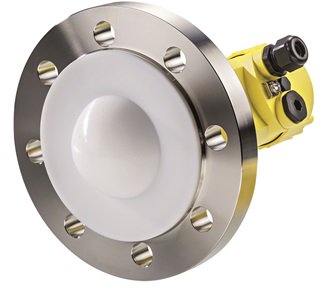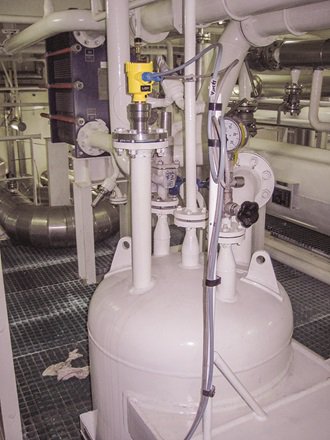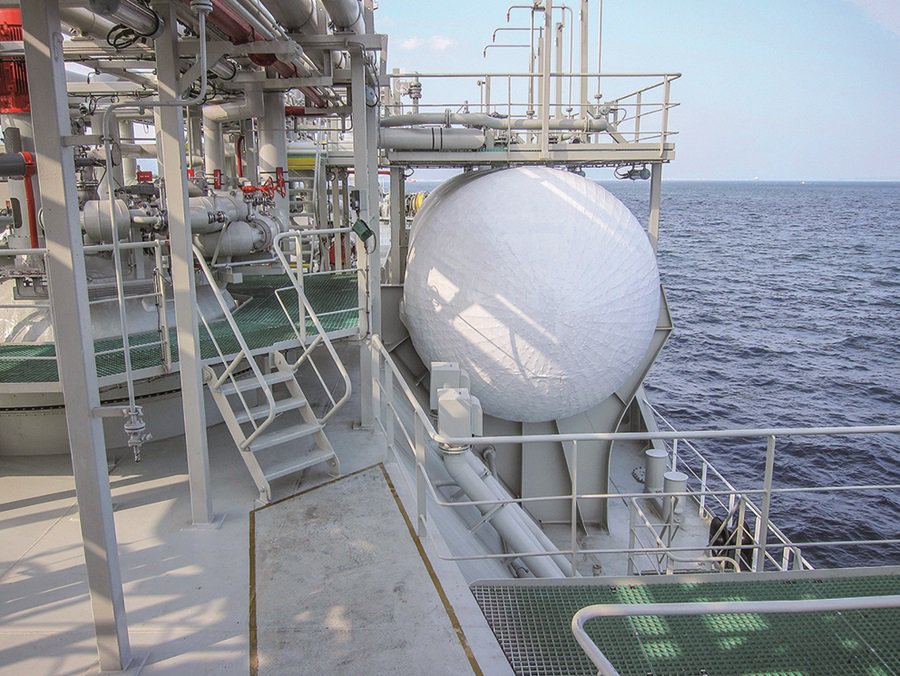VEGAPULS 64 radar level sensor proves its prowess in the LNG/LPG process chain
A demanding medium
The radar sensor for liquids VEGAPULS 64 (flange version) is ideally suited for poorly reflecting media, i.e. liquids with small DK values.
There are physical properties of LNG/LPG which can also vary depending on the composition of the medium; this can be due to supplier, its origin, refined state, as well as variations on storage and ambient conditions. Due to this, many measuring principles struggle to deliver a reliable, precise measurement without recalibration. Mechanical measuring methods are known to be prone to malfunction and require a lot of maintenance. For these reasons, a contactless radar technology is clearly the measuring method of choice. However, LNG/LPG also has a low density and a very small dielectric constant (which affects its reflectivity to microwave-based radar measurement systems). In the past, this has meant special installations like stilling tubes and specific configurations of radar were required to function reliably. They also need to be able to deal with internal fittings, isolation valves, poor reflections and sometimes turbulent surfaces, and these have even presented some reliability problems for radar in the past.
Poorly reflective media
The outstanding focusing makes the measurement more reliable and accurate and the level transmitter less expensive to plan and implement. To assist with this, it is available with a range of different antenna systems and sizes. Currently, the connection sizes (with beam angles in brackets) on offer range from ¾"(14°), 1½" (7°), DN50/2” (6°) and DN80(3°).
When it comes to any problematic internal fixtures, the focusing advantage also has a positive benefit. The most obvious: the narrow measuring beam can simply avoid any internal tank components and installations, but it doesn't end there…
The isolation valve challenge
For a radar level sensor, this means that it has to be mounted on a ball valve. The purpose of this is to guarantee that the sensor can be separated from the process even during ongoing operation. Until now, installing a radar sensor on a ball valve was not recommended, as the ball valve itself causes large interfering reflections in the close range. This is due to reflections at internal valve sealing and seating points as well as from process connections like flanges and gaskets. These small, near range signals are generated inside the throat of the ball valve, they consequently multiply and feedback interfering signals, which usually directly impede the measuring path of the sensor. In the past, reliable measurement with radar through a ball valve was often impossible, or severely restricted, especially in liquids with small dielectric values.
With VEGAPULS 64, the influence of the ball valve is much smaller again because of the considerably better signal focusing of the sensor. As a result, the ball valve generates no disturbing echoes, interfering signals in the close range are thus avoided and a reliable measurement is assured. Another benefit for the user: the sensor can be installed onto existing shut-off devices and on longer nozzles, which also keeps the costs of retrofitting to a minimum.
Better utilization of tank volume
Thanks to the significantly shorter wavelength of the 80 GHz signals from VEGAPULS 64, the signals that reflect back are much higher in strength - and any that do pass through the surface into the medium are strongly attenuated (much more than with previous radar sensors). As a result, any unwanted reflections from the bottom of the vessel are significantly weaker. Even at low levels, this means the liquid level signal reflected back remains stronger than the unwanted signal from the bottom. This means, even at the very lowest levels, the liquid surface can be detected reliably and accurately, allowing the tank volume to be even better utilized.
Conclusion: VEGAPULS 64 offers a reliable, contactless level measurement that can be easily retro fitted and isolated, needs minimal engineering and enables better performance in LPG and LNG processing, shipping and storage.
Products
Export this article
Download as PDFShare this article
Comments ({{comments.length}})
{{getCommentAuthor(comment, "Anonymous")}} {{comment.timestamp | date : "dd.MM.yyyy HH:mm" }}
{{comment.comment}}








